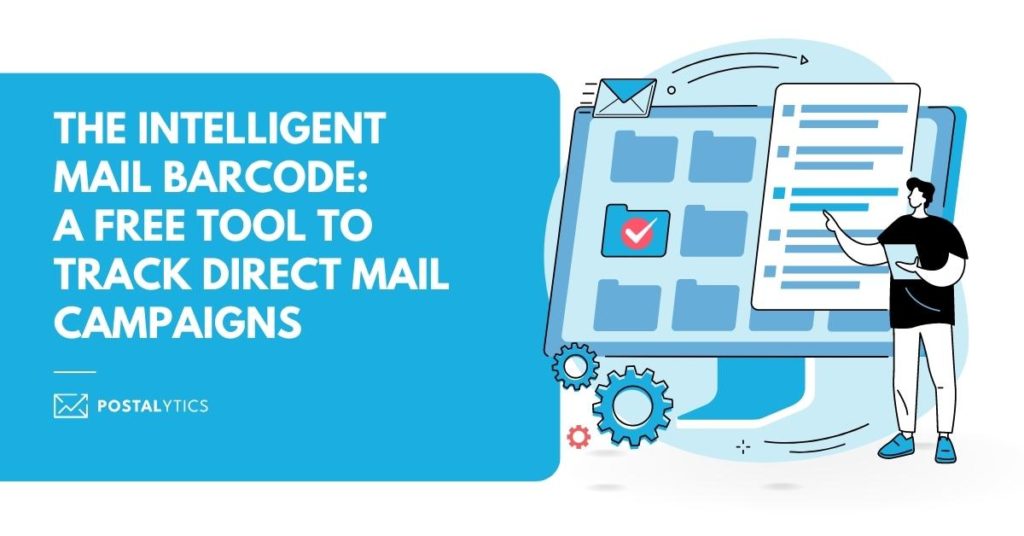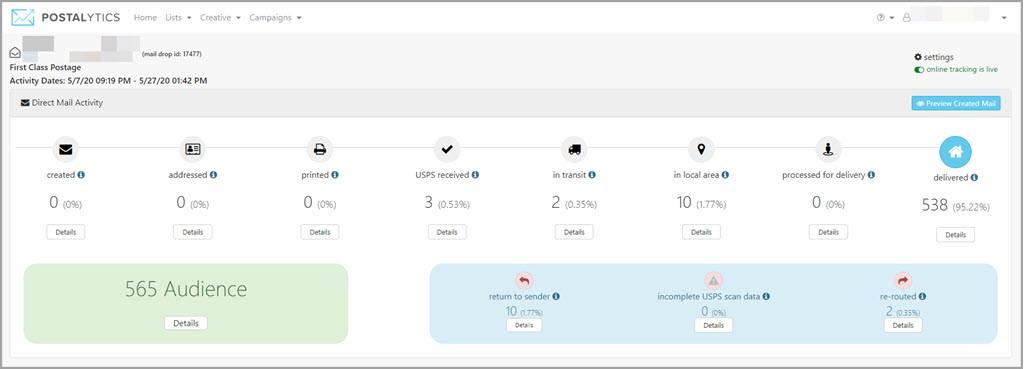
Are you struggling to keep track of your direct mail campaigns? Even worse, are you wasting money on undeliverable mail? You’re not alone.
As the leading direct mail automation platform, we spend a lot of time studying how mail delivery works.
The U.S. Postal Service is well known to everyone, but what you probably don’t see is the massive logistics infrastructure that supports its operations. The USPS moves about 140 billion pieces of mail each year (that’s around 380 million per day!), employs 500,000 people, and manages over 31,000 retail post office locations, according to USPS themselves.
Many marketers leverage this incredible infrastructure by sending direct mail offers and messages directly into the hands of their target audiences. But the most sophisticated marketers are actually lowering their mailing costs while tracking each of their mailers by taking advantage of a virtually unknown USPS tool called the Intelligent Mail Barcode, or IMB system.
Table of contents
- What is an Intelligent Mail Barcode?
- Trace mail for free, if you can figure it out…
- Direct Mail Marketing Automation tools make using IMB easy
- Intelligent Mail Barcodes: A clearer view of direct mail delivery
- How does the intelligent mail barcode system work?
- Turning scan event data into information you can actually use
- Why waste money on undeliverable mai l when you don’t have to?
- Informed Visibility: A clear picture of when mail will be delivered
- Intelligent mail made even smarter
What is an Intelligent Mail Barcode?
The Intelligent Mail Barcode is a system designed by the USPS that includes a unique 65-bar postal barcode that is assigned to individual mailers. This barcode gets printed in designated address areas of specifically sized and designed postcards, letters, and flats.

The IMB system was originally developed for internal use by the USPS. Automated, high-speed sorting machines are able to read the barcodes and route individual mailpieces to their appropriate destinations using the data stored in the barcodes.
What type of data does an intelligent mail barcode contain?
There are 31 pieces of postal data stored in those 65 vertical bars, which enable efficient sorting and routing by automated equipment. It acts as a key to communicating to high-speed sorting machines both who is sending the mailer and where it is going. The data includes:
- The class of mail (first-class, standard, or marketing mail)
- The identity of the mailer
- Any automation discounts the mail qualifies for
- The destination ZIP code
- A unique serial number that identifies the mailpiece for tracking purposes
Trace mail for free, if you can figure it out…
Most marketers don’t spend a lot of time researching mailing logistics, so it might be a surprise to learn how powerful and scalable this USPS tool can be. As it turns out, the Intelligent Mail Barcode system is a highly sophisticated set of technologies designed to help direct mail marketers run more effective campaigns and reduce costs. And best of all, it’s free!
That sure seems smart to me, but unfortunately, actually using intelligent mail barcodes gets really complex. The set-up procedures include a byzantine set of documents that would put most people to sleep. And you’d likely need to hire some pretty experienced software developers to set them up properly because the technology behind these codes is pretty intense.
Not only is the set-up process needlessly complex, but the data that makes Intelligent Mail so smart isn’t organized very well. If you rely on USPS alone, you’ll likely be scratching your head quite a lot. That’s because, for every useful piece of data that helps you improve campaign performance, there may be dozens of other data points that are completely irrelevant to tracking your mail.
Direct Mail Marketing Automation tools make using IMB easy

The good news is that there’s a range of powerful but easy-to-use software tools designed to help marketers leverage the Intelligent Mail Barcode system. Direct mail automation is rapidly becoming a growing category of marketing technology that is transforming the way that marketers think about direct mail.
Especially when it comes to using the intelligent mail barcode system. For example, every piece of mail sent through Postalytics automatically gets assigned an IMB to track in your dashboards for free.
Tools like Postalytics are designed to be completely compatible with IMB and cut out all the needless complexity that can prevent you from taking advantage of all the benefits this system can deliver to your bottom line.
Intelligent Mail Barcodes: A clearer view of direct mail delivery
The term “intelligent mail” refers to an entire set of solutions that USPS offers marketers to help save money on postage but also track mail after it’s sent. That makes it easy to verify delivery — and even better, more accurately plan other marketing activities in coordination with your direct mail program so that you can execute more integrated campaigns.
Even only a few years ago, when you sent out a mailing, you only had a vague idea of when it would reach its destination. You might not even know if your mail was even delivered, and even if you did find out, it could take weeks to get those reports.
That all changed when USPS started rolling out the Intelligent Mail Barcode system into its systems and processes. Barcode technology has been used for years in many industries, so it is a stable, reliable infrastructure. When applied to managing mailing logistics, it can provide a powerful tool for accessing data about your marketing mail.
Now, marketers can get access to critical data within hours of scans being captured in USPS facilities all over the country. But you’ll need software to filter the noise (the internal USPS tracking jargon) from the nuggets of important information.
Once set up, you can figure out where your mail is, when it is being delivered and which mailers aren’t going to be delivered because of address issues.
How does the intelligent mail barcode system work?

We’ve referenced the fact that there’s a ton of data generated by the Intelligent Mail Barcode system. Why? Because the logistics developed to deliver mail to any location in the U. S. within a couple of days is really complex.
There are several tightly coordinated hand-offs involved in creating and sending direct mail that will be managed by the intelligent mail barcode system. Here’s how it works:
1. Printing and mailing with a direct mail automation tool — or using; a commercial printer or mail house to set up IMB tracking
While anyone can print and mail using the freely distributed Intelligent Mail Barcode tools, most marketers use a commercial printing and mailing service. Because these codes are so complex, it is easier to work with a service that has already been set up and has the proper equipment and experience mailing within the parameters of the intelligent mail barcode system.
It’s important to know that to use the Intelligent Mail Barcode system, marketers must use mailing formats that have been approved by the USPS. There are specific dimensions, weights, address and barcode locations, and data processes that must be followed in order for a mailing to qualify to use the intelligent mail barcode.
Direct mail automation vendors, commercial printers, or mail houses can use approved USPS software to “Presort” the mail into the proper order, run addresses through the CASS and NCOA databases (to standardize and cleanse addresses), and print the address and barcodes in designated areas so intelligent mail barcodes can be properly scanned. All of these processes are crucial to ensuring that the printed Intelligent mail barcodes will be accepted by the USPS.
2. Handoff to the USPS Entry Facility
The first Intelligent Mail Barcode “scan event” that you see will often appear at some point after the USPS takes custody of your mailers. Typically, the printer/mail house sends the mail by truck to what’s known as an “Entry Facility” or “Network Distribution Center” (NDC). These are huge regional warehouses where all outgoing mail is shipped to for sorting and routing. There are 21 NDCs across the U.S.
NDCs have highly automated sorting equipment that uses the Intelligent Mail Barcode to quickly route each mailer to the next stop on its journey, which may be to another NDC. There can be many scans while the mail is being processed in these NDCs.
3. Shipping to the USPS Destination Facility
Next, your mailers are routed to “Destination Facilities” or “Sectional Center Facilities” (SCFs). These are regional facilities that route mail between NDCs and local post offices. Additional sorting and scanning occur at SCFs. There are 195 SCFs in the U.S., each assigned to geographic service areas defined by one or more three-digit ZIP code prefixes.
4. Shipping to local post offices and sending out for delivery
From there, local post offices receive mail from trucks, and there are more scan events generated. For many mailers, this is where the final scan event occurs prior to delivery. Others receive scan events when the mailers are out for delivery, using a “geofencing” method.
What is a delivery point zip code?
A delivery point zip code (DPBC) is a five-digit code that is used by the United States Postal Service (USPS) to identify a specific delivery location within a postal code. This code is typically added to the end of a standard five-digit zip code and is used to refine the delivery location further. The delivery point barcode is used to sort and route mail more efficiently and can also be used to validate an address or track mail.
Turning scan event data into information you can actually use

USPS scans these barcodes as they move through the mail system, but a piece of mail can be scanned 200 times or more. Which scans are most relevant?
When you use Postalytics, not only can you be sure your Intelligent Mail Barcode is accurately printed, but you can also access essential data you need to track your mail without needless distraction from notifications that are basically useless. Whether you mail a few pieces per day or thousands, you can use Postalytics to use delivery data more effectively easily.
Delivery data from intelligent mail barcode
One benefit of using the intelligent mail barcode is that not only can you track mail and verify delivery, but you also use this information to improve direct mail performance. That’s because knowing when mail is about to be delivered and when it’s actually delivered makes it a lot easier to manage communications you might send through other media – either before or after a mailing – to enjoy all the benefits of multi-channel campaigns.
CRM or Marketing Automation integration
If your campaign uses data from your CRM or Marketing Automation systems and you import it into Postalytics using our integrations, you can use intelligent mail barcode data to update Contacts, Workflow, reporting, and more.
Often, marketers like to time other communications to the recipients of a direct mail campaign around delivery. Rather than guessing like in the old days, now your CRM or Marketing Automation tools can access Postalytics IMB scan event data and automatically send emails, trigger sales calls, and more based on when mailers are delivered.
Why waste money on undeliverable mail when you don’t have to?
As I’ve mentioned before, one surefire way to ensure no response to a mailing is to send it to an invalid address. Yes, that happens occasionally, but it’s far less common when you use Intelligent Mail Barcode data and Postalytics.
Once you get a report that a piece of mail is undeliverable (or forwarded), that information automatically updates your Postalytics mailing list. So sending one piece of mail to an undeliverable address may be excusable, but now there’s absolutely no excuse for that to happen a second time. You’d be surprised how just the savings on preventing undeliverable mail can really add up. Eliminating even 1,000 undeliverable mailers can save you hundreds of dollars.
And that represents just postage costs. You see, in the “olden days” (like only a few years ago), notices about returned mail could trickle in over a month or more and require manually inputting new address information Now that process is completely automated to save many hours of valuable time and eliminate tedious tasks.
Informed Visibility: A clear picture of when mail will be delivered
One new feature USPS recently introduced makes intelligent mail even smarter – Informed Visibility.
Before this feature was introduced, you couldn’t track each piece of mail in real time because scans at post offices didn’t provide the accurate delivery information. Informed Visibility, however, uses scans to inform you when mail is actually loaded onto a delivery truck, not just when it reaches a post office. That gives you a far more accurate view of actual delivery dates.
This information makes it even easier to time other marketing activities in your multi-channel campaigns. And, of course, Informed Visibility data is available through your Postalytics Campaign Dashboard, is seamlessly integrated into your favorite CRM and marketing automation solution, and is easily exported into other applications through our convenient API.
Informed Visibility also helps you keep your lists even more accurate. Even when you process mail through various databases such as NCOA and CASS that include data on people who have moved, there are some cases when these databases haven’t been updated as quickly as needed. But with Informed Visibility, you’ll know a lot sooner when a specific piece of mail won’t reach a customer or prospect because of a recent move.
Intelligent mail made even smarter
Using intelligent mail barcode is definitely one smart move.
Even smarter? Using Postalytics to make using Intelligent mail barcodes even easier to simplify workflows, evaluate campaign performance, and improve future campaigns.
About the Author

Dennis Kelly
Dennis Kelly is CEO and co-founder of Postalytics, the leading direct mail automation platform for marketers to build, deploy and manage direct mail marketing campaigns. Postalytics is Dennis’ 6th startup. He has been involved in starting and growing early-stage technology ventures for over 30 years and has held senior management roles at a diverse set of large technology firms including Computer Associates, Palm Inc. and Achieve Healthcare Information Systems.
